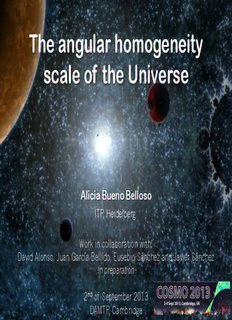
The angular homogeneity scale of the Universe - Centre for PDF
Preview The angular homogeneity scale of the Universe - Centre for
The angular homogeneity scale of the Universe Alicia Bueno Belloso ITP, Heidelberg Work in collaboration with: David Alonso, Juan García-Bellido, Eusebio Sánchez and Javier Sánchez in preparation 2nd of September 2013 DAMTP, Cambridge Introduction: a homogeneous or fractal universe? • Usual assumption: the Universe is homogeneous and isotropic on large scales Alicia Bueno Belloso The angular homogeneity scale of the Universe 2nd September 2013 Introduction: a homogeneous or fractal universe? • Usual assumption: the Universe is homogeneous and isotropic on large scales • Homogeneous regime is not realised on small scales, due to the form of the spectrum of matter perturbations and to their evolution via gravitational collapse. Alicia Bueno Belloso The angular homogeneity scale of the Universe 2nd September 2013 Introduction: a homogeneous or fractal universe? • Usual assumption: the Universe is homogeneous and isotropic on large scales • Homogeneous regime is not realised on small scales, due to the form of the spectrum of matter perturbations and to their evolution via gravitational collapse. • The primordial spectrum of metric perturbations is predicted to be almost scale-invariant by inflation, still expect some level of inhomogeneities Alicia Bueno Belloso The angular homogeneity scale of the Universe 2nd September 2013 Introduction: a homogeneous or fractal universe? • Usual assumption: the Universe is homogeneous and isotropic on large scales • Homogeneous regime is not realised on small scales, due to the form of the spectrum of matter perturbations and to their evolution via gravitational collapse. • The primordial spectrum of metric perturbations is predicted to be almost scale-invariant by inflation, still expect some level of inhomogeneities • Different groups have argued that the Universe might not reach homogeneity on large scales, and that it behaves like a fractal… Pietronero. et al., 1997, Critical Dialogues in Cosmology, 24 F. Sylos Labini, et al., Europhys. Letters 2009 Alicia Bueno Belloso The angular homogeneity scale of the Universe 2nd September 2013 Introduction: a homogeneous or fractal universe? • Usual assumption: the Universe is homogeneous and isotropic on large scales • Homogeneous regime is not realised on small scales, due to the form of the spectrum of matter perturbations and to their evolution via gravitational collapse. • The primordial spectrum of metric perturbations is predicted to be almost scale-invariant by inflation, still expect some level of inhomogeneities • Different groups have argued that the Universe might not reach homogeneity on large scales, and that it behaves like a fractal… • … while other groups claim the opposite result!! Pietronero. et al., 1997, Critical Dialogues in Cosmology, 24 Scrimgeour, M., et al., 2012, MNRAS, 425, 116 F. Sylos Labini, et al., Europhys. Letters 2009 Nadathur, S. 2013, MNRAS, 434, 398 Alicia Bueno Belloso The angular homogeneity scale of the Universe 2nd September 2013 Introduction: a homogeneous or fractal universe? • To measure this transition observationally, large survey volume is necessary Alicia Bueno Belloso The angular homogeneity scale of the Universe 2nd September 2013 Introduction: a homogeneous or fractal universe? • To measure this transition observationally, large survey volume is necessary • Ideal for photometric galaxy redshift surveys such as DES The Dark Energy Survey Collaboration, arXiv:0510346, 2005 Alicia Bueno Belloso The angular homogeneity scale of the Universe 2nd September 2013 Introduction: a homogeneous or fractal universe? • To measure this transition observationally, large survey volume is necessary • Ideal for photometric galaxy redshift surveys such as DES Due to photometric uncertainty Radial information is lost The Dark Energy Survey Collaboration, arXiv:0510346, 2005 Alicia Bueno Belloso The angular homogeneity scale of the Universe 2nd September 2013 Introduction: a homogeneous or fractal universe? • To measure this transition observationally, large survey volume is necessary • Ideal for photometric galaxy redshift surveys such as DES Due to photometric uncertainty Radial information is lost Must use estimator with only angular info Advantage: Angles are model-independent! The Dark Energy Survey Collaboration, arXiv:0510346, 2005 Alicia Bueno Belloso The angular homogeneity scale of the Universe 2nd September 2013
Description: